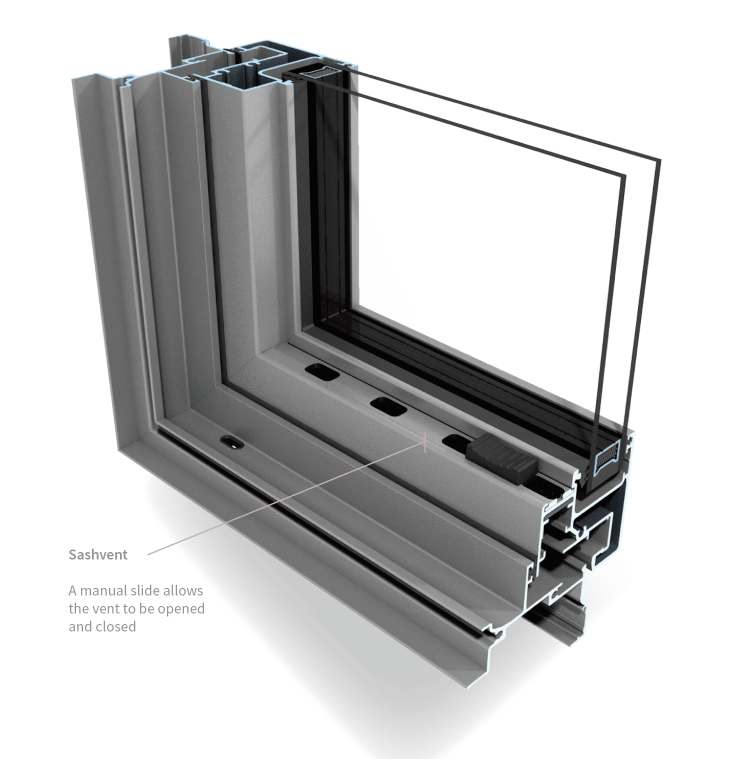Passive ventilation is the natural system of ventilation taking fresh air from outside and allowing it to circulate throughout your home. It has a host of benefits for your health, home, and life.
Breathing fresh air is something we can’t take for granted. With so many of us spending the vast majority of our lives inside, often breathing recycled air from heating and cooling systems, it is important to find ways to bring in natural good ventilation into our homes and office spaces wherever possible. And a cost effective and easy way to do this is by installing windows or doors that have passive ventilation features.
What is passive ventilation?
Passive ventilation is air circulation brought into an indoor space through natural ventilation methods, using openings like window vents, windows or doors. Stale air goes out and in comes fresh air into your home. It uses the position of the house, the placement of windows, the type of windows, and the layout being designed to take advantage of the area’s prevailing wind and weather patterns.
For passive ventilation to work, a house needs at least 15 minutes of ventilation a day, five times a week. But it depends on your climate, the house design, and what the weather is doing.
Why passive ventilation is important
The air we breathe when stuck inside is hardly the healthiest, with gaseous pollutants like carbon monoxide and carbon dioxide, as well as moisture and various allergens circulating. Fake fragrances, cooking smells, and a range of chemical-emitting paints and furnishings make our homes and offices unhealthy. Passive ventilation is the solution.
This is achieved by designing windows or doors that bring fresh air into your home, while also providing an outlet for stale air. Passive ventilation also improves the energy efficiency of your home, making it easier to heat in the winter time.
Depending on whether you want to let cool air in during the warm summer months, or have fresh air come in during winter time to relieve the stuffiness and remove excess moisture, passive ventilation is the best solution. In summer, opening windows, especially those placed higher off the ground level or on a top floor, gives the warm air that has gathered inside an escape route. A good passive ventilation system will allow for clean air to enter without your precious heat escaping in winter. This means that whether it is for the hot or cold months, passive ventilated windows are energy efficient and will help you decrease your carbon footprint.
Passive ventilation works best if your space is designed for the free flow of air from windows across rooms – having windows that are placed across from each other on two ends of a room or when there is a hallway in between improves the natural air circulation opportunities. Just by opening and closing windows designed for passive ventilation, you can regulate the indoor temperature as well as improve indoor air quality. It is important to have openable windows on each level of your building.
Advantages of passive ventilation in windows
Having passive ventilation in your windows is a cost effective way to have good background ventilation into your home or other indoor spaces. With openable windows designed with vents for passive ventilation, you only have to open and close them to achieve a reduction in temperature and have clean air flowing through your space.
Cleaner, less polluted air (that occurs as a result of recycled air we end up breathing indoors) is beneficial for your health as well as keeping your home or office structure free from mildew, mould and other issues that can cause long term structural damage, as well as respiratory or skin issues. In addition, passive ventilation makes it easier and more efficient to heat the indoors, which equates to energy and cost savings.
Passive ventilation options for windows
There are a range of ventilation solutions that help you to ensure a warm, dry, well-ventilated home. Choose windows such as ThermalHeart windows, that offer excellent thermal properties- double glazed windows that keep the heat in, the cold out, and minimise condensation.
Then, think about the design of your home and how it sits on the site. Getting a cross-breeze is ideal- what is the prevailing wind on the section?
Involving window specialists in the design of your home will help to choose the best window options. Aluminium windows whether they are louvre, casement, awning, sliding, bi-fold, double hung or sliding offer passive ventilation. Side-opening windows may be a good option for catching the breeze and bringing it into the house. It really depends on your home design and the location—every home is different.
Contact us to discuss the options that will be best for passive ventilation in your home. Our years of experience, knowledge of the industry and understanding of Auckland’s climate make us the experts. We can help you choose the best window types, the most effective design, and ensure you have a warm, dry, healthy home for many years to come.
View All Articles